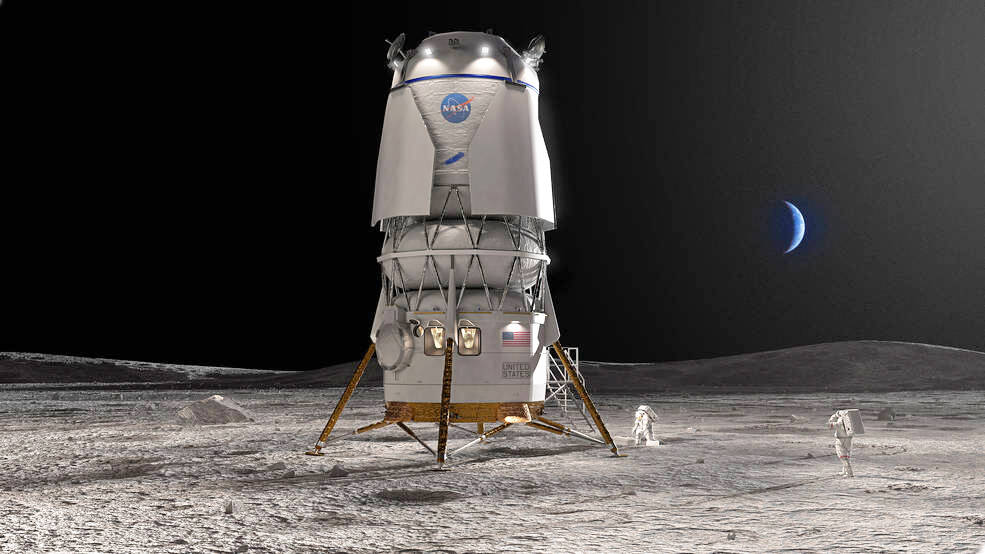NASA selected Kent-based Blue Origin for a $3.4 billion contract to develop a human landing system for the agency’s Artemis V mission to the Moon.
Under this contract, Blue Origin and its National Team partners will develop and fly both a lunar lander that can make a precision landing anywhere on the Moon’s surface and a cislunar (between the Earth and the Moon) transporter, according to a Blue Origin email. The partners include Lockheed Martin, Draper, Boeing, Astrobotic and Honeybee Robotics.
“Today (May 19 announcement) we are excited to announce Blue Origin will build a human landing system as NASA’s second provider to deliver Artemis astronauts to the lunar surface,” said NASA administrator Bill Nelson. “We are in a golden age of human spaceflight, which is made possible by NASA’s commercial and international partnerships. Together, we are making an investment in the infrastructure that will pave the way to land the first astronauts on Mars.”
The total award value of the firm-fixed price contract is $3.4 billion, according to NASA.
Through Artemis, NASA will explore more of the Moon than ever before, uncovering more scientific discoveries, and preparing for future astronaut missions to Mars, according to nasa.gov.
Blue Origin will design, develop, test and verify its Blue Moon lander to meet NASA’s human landing system requirements for recurring astronaut expeditions to the lunar surface, including docking with Gateway, a space station where crew transfer in lunar orbit, according to NASA. In addition to design and development work, the contract includes one uncrewed demonstration mission to the lunar surface before a crewed demo on the Artemis V mission in 2029.
“This is great news for Washington state and our growing aerospace industry,” said U.S. Sen. Patty Murray, D-Washington, in a press release. “Our state has long been a leader in aerospace innovation and played a key role in so many of our nation’s milestones in space — so it’s fitting that Kent’s own Blue Origin was chosen to develop a human landing system for NASA’s Artemis V mission.
“Space exploration is not only about pushing the frontiers of innovation and discovery, but about inspiring our next generation to discover what’s possible—and I couldn’t be more excited for this mission. As chair of the Senate Appropriations Committee, I will do everything I can to support investments in innovation right here in Washington state.”
Blue Origin opened in Kent in 2020 and is owned by Amazon founder Jeff Bezos.
According to NASA, for the Artemis V mission, NASA’s SLS (Space Launch System) rocket will launch four astronauts to lunar orbit aboard the Orion spacecraft. Once Orion docks with Gateway, two astronauts will transfer to Blue Origin’s human landing system for about a weeklong trip to the Moon’s South Pole region where they will conduct science and exploration activities.
Artemis V is at the intersection of demonstrating NASA’s initial lunar exploration capabilities and establishing the foundational systems to support recurring complex missions in lunar orbit and on the surface as part of the agency’s Moon to Mars exploration approach, accordng to NASA.
Adding another human landing system partner to NASA’s Artemis program will increase competition, reduce costs to taxpayers, support a regular cadence of lunar landings, further invest in the lunar economy, and help NASA achieve its goals on and around the Moon in preparation for future astronaut missions to Mars, according to NASA.
The agency previously contracted SpaceX, (founded by by Elon Musk, owner of Tesla and Twitter) to demonstrate an initial human landing system for the Artemis III mission. Under that contract, the agency also directed SpaceX to evolve its design to meet the agency’s requirements for sustainable exploration and to demonstrate the lander on Artemis IV.
As a result of the contract with Blue Origin to demonstrate on Artemis V a lander that meets these same sustainable lander requirements, including capabilities for increased crew size, longer mission duration, and delivery of more mass to the Moon, multiple providers will be available to compete for future opportunities to fulfill NASA’s lunar surface access needs for Artemis missions.
By supporting industry’s development of innovative human landing system concepts and designs, NASA officials said it will help increase access to space for the benefit of all.
“Having two distinct lunar lander designs, with different approaches to how they meet NASA’s mission needs, provides more robustness and ensures a regular cadence of Moon landings,” said Lisa Watson-Morgan, manager, Human Landing System Program at NASA’s Marshall Space Flight Center in Huntsville, Alabama. “This competitive approach drives innovation, brings down costs, and invests in commercial capabilities to grow the business opportunities that can serve other customers and foster a lunar economy.”
Through Artemis, NASA will send astronauts – including the first woman and first person of color – to explore the Moon for scientific discovery, economic benefits, and to build the foundation for crewed missions to Mars. Together, the SLS rocket, Orion, Gateway, advanced spacesuits and human landing systems are NASA’s foundation for deep space exploration.
For more information about the human landing system, visit: go.nasa.gov/45fK6qY.
Talk to us
Please share your story tips by emailing editor@kentreporter.com.
To share your opinion for publication, submit a letter through our website https://www.kentreporter.com/submit-letter/. Include your name, address and daytime phone number. (We’ll only publish your name and hometown.) Please keep letters to 300 words or less.

